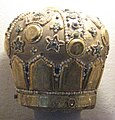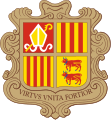Miter

The Mitra ( ancient Greek μίτρα , diadem ' ; plural mitres ) is the traditional liturgical headdress of bishops of many Christian churches. Other ecclesiastical dignitaries with their own area of jurisdiction (e.g. certain abbots ) also wear mitres. Today, the miter is only worn during pontifical acts in worship.
Appearance and shape
Since the 11th century, the miter, which belongs to the pontificals , has developed into its present form in the Church (except in most Eastern Churches ). The covering of the head consists of the two upside-down shields (cornua) on the forehead and neck . The inner lining of the miter is still similar to a hat. This is covered by firmer fabric that tapers at the front and back. Backwards hang two pendilia tapes, called Vittae , down to the shoulders; these two ribbons are symbolic of the Old and New Testaments .
In this form, the miter is worn today primarily by Old and Roman Catholic bishops and infuled abbots and prelates , but also by Anglican and some Eastern Church bishops, such as the Armenian Orthodox , the bishops of the Mar-Thoma Church is common, but also by some bishops of the Eastern Churches united with Rome . The use of the miter is also widespread in a number of Lutheran churches, e.g. B. in the Evangelical Lutheran Church of Latvia and in the Swedish Church .
In the Catholic Church of the West there were three different classes of miter (today only in the so-called extraordinary form of the Roman rite ):
- Mitra pretiosa - the "precious miter" is usually richly decorated (especially older mitres are sometimes decorated with jewels and semi-precious stones and embroidered with gold thread)
- Mitra auriphrygiata - the "golden miter" is either made of a continuous gold-colored fabric or is made of white silk with gold and silver threads embroidered.
- Mitra simplex - the "simple miter" consists of white silk damask , silk or linen. The vittae end in red fringes.
As a rule, two mitres were always used during the pontifical functions; H. either Mitra pretiosa and Mitra auriphrygiata or Mitra auriphrygiata and Mitra simplex. Their use was last regulated in the Caeremoniale episcoporum of 1886.
Since the liturgical reform of the Second Vatican Council , only the following two forms of miter are normally used:
- Mitra simplex - the "simple miter" and
- Miter ornata - the "decorated miter".
Your choice depends on the occasion of the celebration, whereby only a single miter is used without changing the model.
The Frauenfeld miter dates from the time of the Council of Constance (1414–1418).
Eastern Churches
In the Orthodox Church , the miter (μίτρα) is a high domed, crown-shaped cap ( Stephanos (bishop's crown ) ). Instead of the ribbons, the miter is enclosed at the back by a cloth. The Katholikoi and bishops of the Armenian Apostolic Church as well as some Eastern Catholic Churches wear a miter of the western kind. The miter (crown) is worn by the bishop, but also by archpriests who have been granted this right. They are called mitrophoroi (bearers). Originally the miter consisted of a metal ring, over which two cross-shaped metal strips were attached. The metal was adorned with enamel , precious stones and pearls , the space in between was filled with velvet , silk or metal flakes. These decorations symbolize the diversity of the virtues of Christ . Symbols of the four evangelists (man, lion, bull and eagle) or small icons were attached to four sides of the metal ring . Since these metal mitres weighed two to three kilograms, lighter, knitted mitres that were decorated with precious fabrics became popular since the end of the 18th century. In the second half of the 15th century, mitres were worn for the first time in the Greek Orthodox Church , modeled on the imperial crown of the Byzantine emperors. A miter was first bestowed in Russia in 1589. Russian mitres are larger than Greek and therefore sit above the eyebrows, while Greek mitres leave the forehead largely uncovered. The miter is set down from the Great Entry to Communion . The bishop wears the miter while reading the gospel, while miter-bearers put it down.
origin
The miter did not appear among the sacred clothing of Western bishops until the 11th century, and much later for Eastern bishops. The exact origin is uncertain. Originally the miter was just a kind of hat, occasionally just a headband. Actually a hallmark of Persian princes, it was adopted by the bishops through various detours. Another opinion says that a miter was already part of the regalia of dignitaries in the Roman Empire and that this headgear was adopted by the church.
heraldry
In heraldry , the miter is a heraldic figure that is generally intended to refer to a bishop or other high saint - for example a local founder, local or church patron. The miter is usually depicted in silver or gold with golden ribbons that hang down on both sides. There are also coats of arms in which the miter and the bishop's staff together form a coat of arms. The miter can also rest on the edge of the shield or be in the upper coat of arms in general . Mitres were (and are partly against the current rule) used in church heraldry to denote the rank of bearer of a coat of arms (bishop, infuled abbot), although in the Catholic Church the coat of arms of bishops and cardinals is usually not of one Miter, but rather raised by a galero . Crowning the coat of arms with a miter has not been permitted for church dignitaries, with the exception of the Pope, since 1969. The miter has since been reserved for the coats of arms of church institutions, e.g. B. a diocese or an abbey . Pope Benedict XVI replaced in his arms previously in papal coat of arms usual Tiara by Mitra.
- Examples of coats of arms with miter
Coat of arms of the state of Andorra
Coat of arms of the municipality of Hawangen
Coat of arms of the municipality of Pleiskirchen
Coat of arms of the Speinshart Abbey
Coat of arms of the municipality of Lans (Tyrol)
Coat of arms of the Diocese of Chur
Coat of arms of the Diocese of Passau according to Siebmacher's book of arms
Varia
A certain sequence of streets in Würzburg is called the "Bischofsmütze", because its pentagonal shape is reminiscent of one. The basis is the right bank of the Main; it is followed by Juliuspromenade, Theaterstrasse, Balthasar-Neumann-Promenade and Neubaustrasse.
See also
- Inful
- Royal armband
- Stephanos (bishop's crown)
- Liturgical robe
- Pileolus , Submitrale, German and skullcap
- Philippi Collection
- Ecclesiastical heraldry
literature
- Bruno Bernhard Heim : Coat of Arms Customs and Law in the Church. Walter, Olten 1947.
- Joseph Braun : The liturgical garment in Occident and Orient by origin and development, use and symbolism. Herder, Freiburg (Breisgau) 1907, pp. 424–498 (Unchanged reprographic reprint. Wissenschaftliche Buchgesellschaft, Darmstadt 1964).
- Bernhard Sirch: The origin of the episcopal miter and papal tiara (= church historical sources and studies. Vol. 8). EOS-Verlag, St. Ottilien 1975, ISBN 3-920289-57-9 (also: Diss. Univ. Munich, 1973).
- Dieter Philippi: Collection Philippi. Headgear in Faith, Religion and Spirituality . St. Benno Verlag, Leipzig, 2009, ISBN 978-3-7462-2800-6 .
- Heidi Blöcher: The Mitres of the High Middle Ages . Abegg Foundation, Riggisberg 2012, ISBN 978-3-905014-51-8 . [art historical study bringing new knowledge]
- Petra Janke: Comments on the baroque mitres from Altenberg . In: Cistercienser Chronik 126 (2019), pp. 84–99. [Study of the use and style of the Mitras in a Cistercian abbey]
Web links
- Images, information and references on the subject of "clerical headgear"
- Images on the subject of "Mitren"
- Bishop's mitres from the Cologne Cathedral Treasury
Individual evidence
- ^ Caeremoniale episcoporum , 1984 edition of Pope John Paul II, No. 60.
- ↑ Nicodemus C. Schnabel: The liturgical vestments and insignia of the deacon, presbyter and bishop in the churches of the Byzantine rite , Echter Verlag, Würzburg 2008, 115–123.
- ^ Elisabeth Trenkle: Liturgical implements and vestments of the Eastern Church , Slavic Institute, Munich 1962, 46f.
- ↑ Athanasios Papas: Liturgische Gewänder , in: Reallexikon zur Byzantinischen Kunst 5 (1995), 741–775, here 766–769.
- ↑ Bernhard Sirch: The Origin of the Episcopal Miter and the Papal Tiara , Eos Verlag, St. Ottilien 1975.
- ↑ http://www.mein-wuerzburg.com/befestigung.htm














